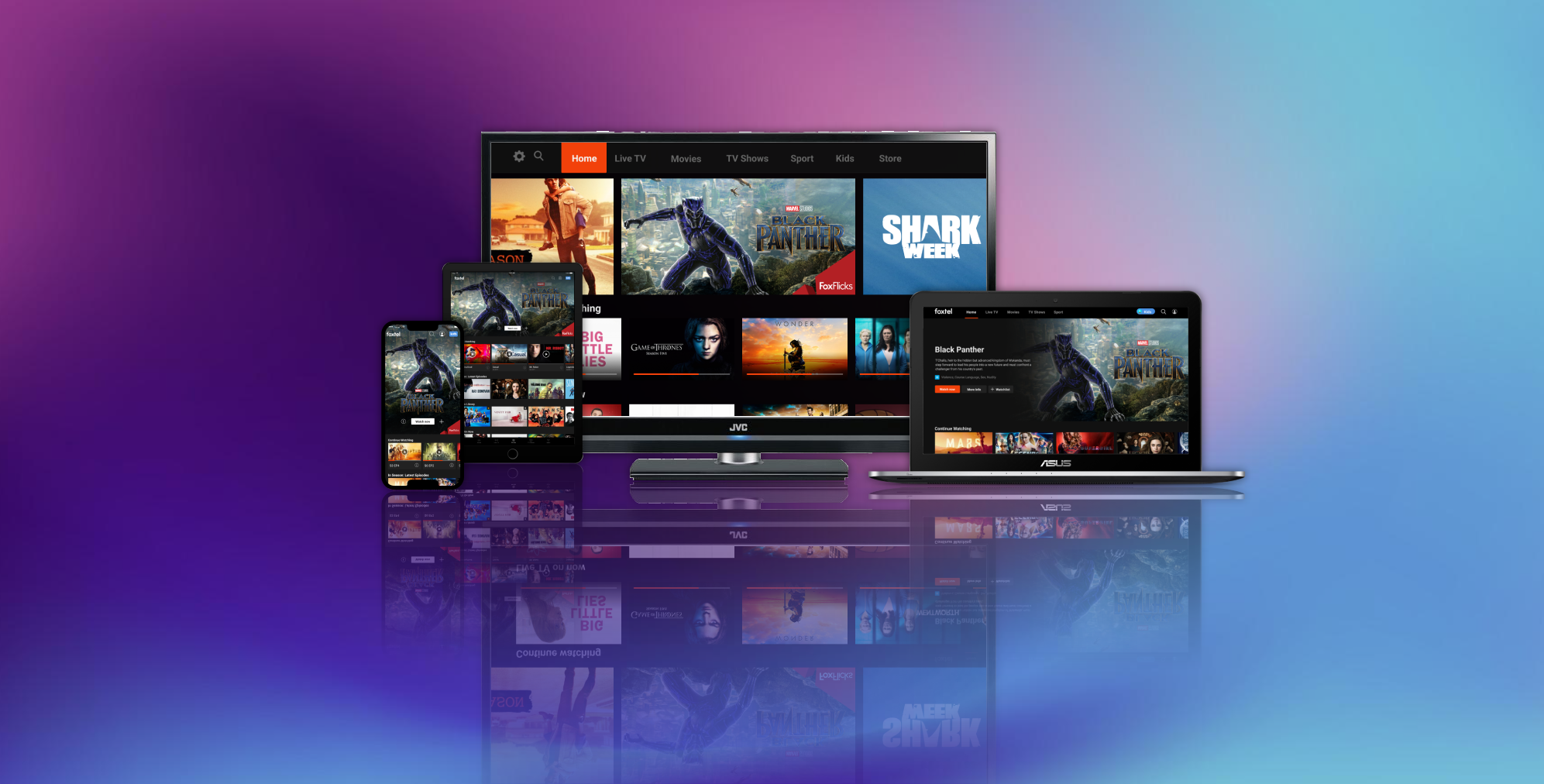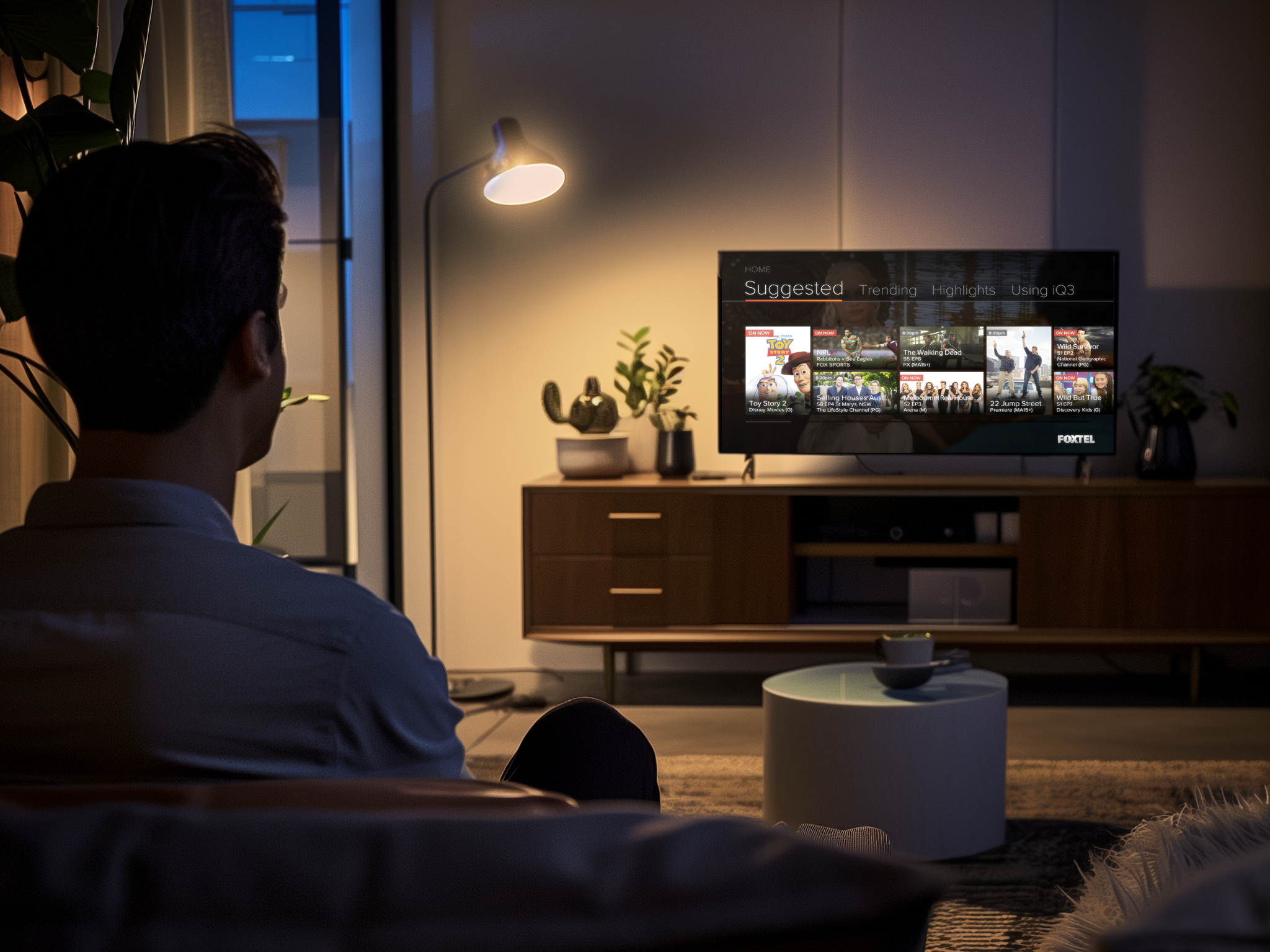
Foxtel iQ5
Creating the iQ5, which became the pinnacle of broadcast and streaming platforms in Australia.
Executive Summary
This project aims to design a world-class user interface (UI) for the iQ5 that not only addresses the shortcomings of its predecessors (iQ3 and iQ4) but also leverages the latest advancements in technology to enhance user experience.
The new UI will provide seamless access to Foxtel’s extensive content library, support ultra-high-definition streaming, and integrate a variety of streaming apps.
Buisness goals
increase in NPS
⬆
⬆
Churn improvement
⬆
increase in ARPU
My role
As the Lead UX Designer for the iQ5 project, I was tasked to redefine the user experience for Foxtel's next-generation set-top box.
TOOLS
Figma
Sketch
InVision
Miro
Jira
Confluence
PROCESS
Discovery & Research
Define
Ideation & UX Design
Prototyping
Customer Testing
Design & Development Collaboration
MY ROLE
UX Research
UX Design
UI design
Usability Testing
Stakeholder Management
Cross-Team Collaboration

In home contextual inquiry was done as part of the discovery
Research & Analysis
To ensure the iQ5 user interface addressed key usability challenges, we conducted extensive user research to analyze pain points and opportunities within the existing iQ3 interface. These insights played a critical role in shaping the design decisions for the new platform.
Research Methodology
A multi-faceted research approach was employed, incorporating both qualitative and quantitative techniques to gain a deep understanding of user behavior and needs. This included:
Contextual Inquiry
Customer Interviews
Surveys
Analysis of Existing Customer Experience Data
iQ Customer Journey Mapping
Synthesis & Key Findings
Over 30 participants were interviewed, generating a substantial amount of qualitative and quantitative data. The research was then synthesized through affinity mapping and thematic analysis to uncover key patterns in user behaviour.
1. Navigation Complexity
2. Content Discovery Challenges
3. A consistent Multi-Device Experience
4. Remote Control & Input Friction
5. Performance & Load Times
6. Create a more personalized experience
7. Customer Support & Self-Service Gaps
iQ Customer Persona
Planning and Ideation
During the early stages of the iQ5 project, the UX and product teams conducted collaborative brainstorming sessions with key stakeholders, including senior leaders from content, technology, and customer experience departments. These sessions were crucial for exploring the feasibility, viability, and desirability of potential features and functionalities for the new set-top box.
Requirements for each feature were meticulously defined and prioritized to align with the project’s goals and user needs, setting the stage for UX sprints focused on design and development..
Stakeholders from various departments, including content, marketing, development, and customer support, were actively involved in quarterly planning sessions, where their insights and feedback helped refine the project’s direction and ensure a cohesive strategy.
Discovery Workshops
Presenting findings to stakeholders
The How Might We statements are based on the workshop outputs:
How might we simplify the navigation flow to make key features and content more accessible to users, particularly for those with less experience?
How might we create a consistent and intuitive user experience across all platforms (TV, mobile, tablet, and desktop) to reduce confusion and enhance usability?
How might we improve content discovery by offering smarter, personalized recommendations and a more seamless search experience?
How might we optimize system performance to reduce load times and lag, ensuring a smooth experience across all devices, including older hardware?
How might we enhance accessibility by improving font sizes, contrast, and UI elements to ensure the platform is usable for all.
How might we provide users with more effective self-service options, such as customisation and settings, to reduce their reliance on customer support?
How might we give users more control over their experience by offering customizable settings, robust user profiles, and advanced filtering options?
How might we improve input methods on TV interfaces, such as by introducing voice recognition or predictive text, to make content interaction more efficient?
Requrements documentation in Confluence
Wireframing and Interaction Design
For the iQ5 project, we adopted a structured approach using 2 week sprints to develop and refine the user interface.
Each sprint began with an Epic Brief and Detailed Requirements to guide our initiatives.
As the Senior UX designer I and my team translated the requirements into wireframes and prototypes, focusing on core user flows for stakeholder reviews and more detailed flows for customer testing.
Wireframing and Interaction Design
Over 500 wireframes and 50 Key user journeys were created in the development of the User Experience.
Key Journey Wireframing and Interaction design
We used Sketch and Figma for Visual Design, creating an component design system that served as the foundation for the iQ5’s user interface.
We facilitated tech review sessions to maintain close collaboration and alignment between
Product
Business Analysis
User Experience
Visual Design
Development teams.
Platform
iQ Figma Designs
The Component and Pattern Library
Played a crucial role in ensuring consistency, scalability, and efficiency in multi-platform design projects. In the context of The iQ project, it likely served as a foundational resource for maintaining a seamless user experience across Television, Mobile, Tablet, and Desktop. Here’s how it contributed to the success of the project:
Ensuring Design Consistency
Improving Efficiency & Collaboration
Streamlining Multi-Platform Adaptation
Facilitating Iteration & Scalability
Component and pattern library
Designing for Every Screen: A Multi-Platform UX Challenge
The iQ was a multi-platform design challenge, requiring deployment across Television, Mobile, Tablet, and Desktop. Each platform presented unique design requirements and challenges.
As the Senior UX Designer, my role was to oversee a team of designers, ensuring consistency across all platforms while delivering the best possible user experience. This was particularly challenging due to
Varying Interaction Models
Consistent Yet Adaptable UI
Technical and Performance Constraints
However, I successfully managed this by leveraging
Strategic Design Leadership
Cross-functional collaboration
User-Centred Approach
Efficient Workflow Management

The iQ design was deployed onto Mobile (iOS and Android), Tablet, Web browser and Television
Development & Deployment
The implementation of iQ5 required significant coordination across both frontend and backend systems, ensuring a seamless transition from development to QA review and, ultimately, to production deployment. This comprehensive process was vital to deliver a high-quality product on time.
Cross-Departmental Support
Operationally, the product team worked closely with various departments, including:
Marketing – Aligning promotional strategies with product features.
Product Copy & Content Teams – Creating clear and effective user-facing content.
Customer Support Documentation – Providing support materials to assist users effectively post-launch.
Marketing Assets Support
We also collaborated with the operations team to define and implement standard operating procedures (SOPs), ensuring a smooth operational transition from launch day and ongoing product stability.
Customer Feedback & Performance Monitoring
As the iQ5 launched, we worked in tandem with the Customer Experience (CX) team to establish a systematic process for collecting and analyzing customer feedback. This feedback loop allowed us to make informed decisions for ongoing product improvements.
To provide real-time insights into product performance, we designed dashboards in Tableau, allowing stakeholders to monitor key metrics across all supported devices. These dashboards facilitated quick decision-making and optimization based on real-time data.
Results
The iQ5 streaming box achieved strong market adoption, leading to a substantial increase in Foxtel subscriptions. The improved user interface, enhanced performance, and more intuitive experience played a key role in attracting new users and driving engagement. Additionally, there was a notable reduction in customer churn, as users found the platform easier to navigate and more aligned with their needs.
22%
increase in NPS
12%
Churn improvemet
4%
increase in ARPU
Conclusion
Foxtel successfully achieved its goal of delivering a world-class entertainment experience with the launch of the iQ5. The enhanced user interface and overall performance improvements were highly praised by customers, who appreciated the seamless navigation, faster load times, and intuitive design.
As the Senior UX Designer, my role was pivotal in driving the design vision from concept to execution. I led the creation of a consistent and intuitive experience across multiple platforms, ensuring the interface was not only user-friendly but also aligned with Foxtel's business objectives. By conducting in-depth user research, iterating on design solutions, and collaborating closely with cross-functional teams, I helped to craft a product that met the diverse needs of our users. The result was a significant increase in subscriptions and improved customer retention, cementing the iQ5 as a key asset in Foxtel's competitive strategy.
TV just got easier
Looking for something to watch? Foxtel offers one solution with entertainment you love, all in one place. Enjoy a new favourite from Foxtel with live sport, world class dramas, and blockbuster movies alongside Netflix, Prime Video, Disney+~, and more all within one interface.












